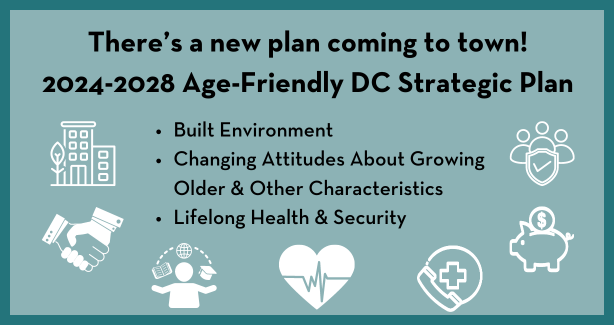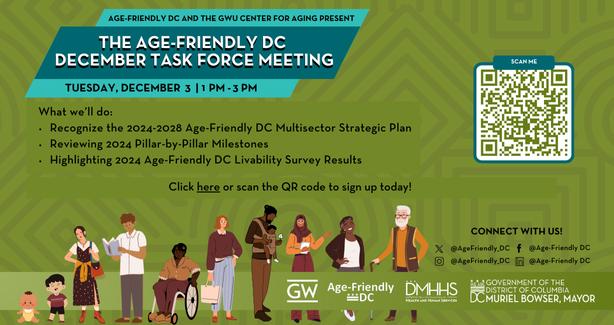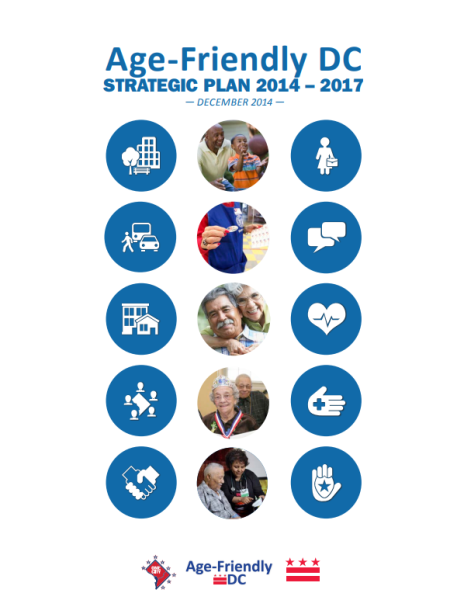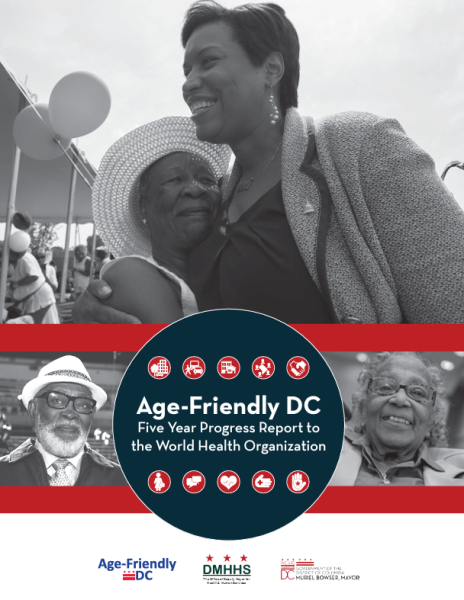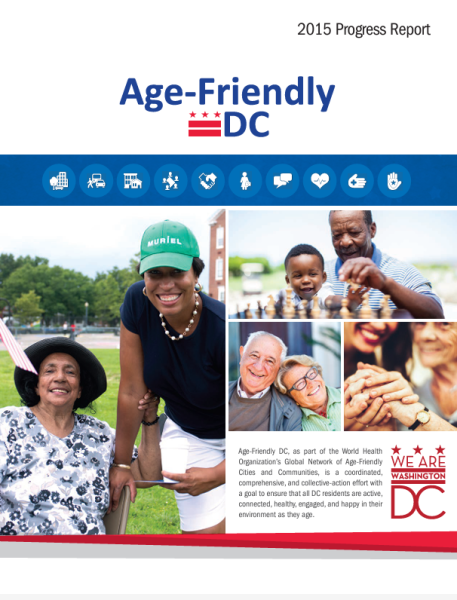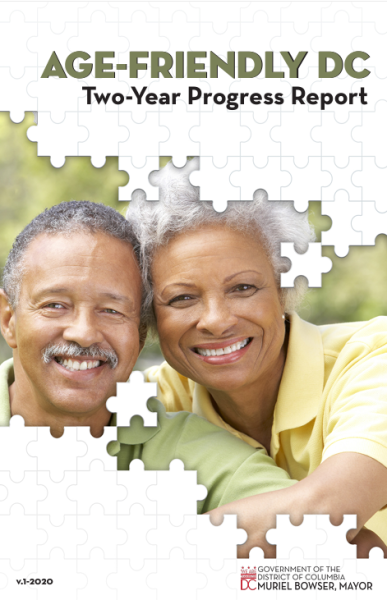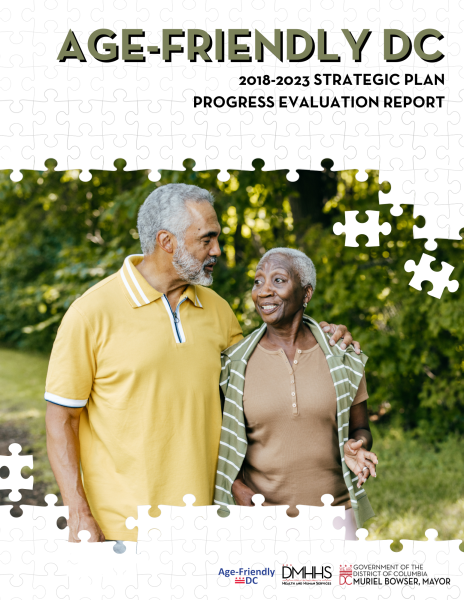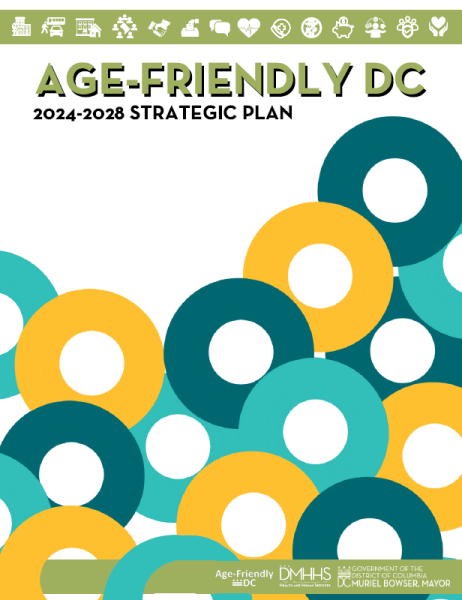AFDC Livability Survey Results Report
Key findings highlight ongoing challenges, including better accessibility, improved pedestrian safety, more affordable and accessible housing, and enhanced social connection programs.

Our History & DC's Progress
In October 2012, the District joined other aspiring jurisdictions through the World Health Organization (WHO) Global Network of Age-Friendly Cities and Communities worldwide on the journey to become an Age-Friendly City. Shortly thereafter, Age-Friendly DC became a founding member of AARP Network of Age-Friendly Communities, when WHO designated AARP to be the United States agent for the initiative. Age-Friendly DC followed the WHO Age-Friendly Cities and Communities framework by listening to thousands of DC residents prior to releasing its first five-year plan.
Age-Friendly DC released its first five-year plan in December 2014. Progress addressing goals and strategies developed by the Task Force and its Domain Task Force Committees was reported annually. In 2017, Age-Friendly DC completed an evaluation, consulting DC residents throughout the city. That evaluation led to the Five-Year Progress Report to the World Health Organization. Both WHO and AARP recognized DC for its Age-Friendly changes, including:
- Converting park equipment in recreation areas for exercise and fun for persons of all ages and abilities
- Launching and continuing Safe at Home, DC’s program modifies homes for aging in place
- Opening Plaza West, with affordable residences for grand families, older adults raising children
- Integrating ride sharing companies and increasing accessible taxis
- Creating intergenerational gardening to maintain school gardens during summer breaks
- Launching and continually growing the number of Age-Friendly Businesses
- Beginning Alternative Pathways to Employment for residents 50 and over to pursue second and third careers
- Training direct service providers in LGBTQ cultural competency
- Providing Senior$afe training to financial securities firm personnel on how to spot and report financial exploitation of older adults
- Promoting an Age-Friendly culture in DC, which has become the foundation for pursuing further changes that make it easier in DC to live work and play
The World Health Organization’s Director of Ageing and Life Course Dr. John Beard traveled from Geneva, Switzerland to congratulate Mayor Muriel Bowser on Age-Friendly progress completed in the District.
In February 2018, Mayor Muriel Bowser established a 2018-2023 Age-Friendly DC Task Force, which forged ahead. Using progress achieved in the first five years as a foundation, the Task Force worked in their committees to recommend content for the new five-year plan. By October 2018, Mayor Bowser released the 2018-2023 Strategic Plan, with a Two-Year Progress Report following in January 2021.
In March 2024, Age-Friendly DC released the 2018-2023 Strategic Plan Progress Evaluation Report. While concluding and evaluating the impact of our second five-year effort, it is important to name COVID-19's impact. The COVID-19 pandemic was sudden, unpredictable, and devastating. We learned the importance of public health, as regular testing, mask-wearing, and vaccinations became our best defenses against the virus. The pandemic also challenged us to adapt and expand our efforts to address each of our fourteen Age-Friendly domains, some of which include:
- Understanding and utilizing technology: We found new tools to connect with family, friends, and colleagues virtually
- Being active outdoors: Walking outside became easier as our sidewalks, street crossings, and parks became more accessible.
- Helping our neighbors: Neighbors helped neighbors more frequently and directly through organizations like DC Villages, which allows residents to age in their own homes among communities they know and love.
- Supporting DC workers: Residents needing time off were able to utilize DC’s Paid Family Leave program.
We’ve made desirable progress thanks to the partnership of the DC Government agencies and community organizations. Click here for more information about our most recent plan progress evaluation.
The most recent strategic plan, Age-Friendly DC 2024-2028, builds on this foundation by focusing on enhancing the physical and social environment and delivering equitable programs and services through three core pillars: built environment, changing attitudes, and lifelong health and security. This plan was developed based on collaboration within the Age-Friendly DC task force and key insights highlighted in the 2018-2023 strategic plan evaluation progress report.
- The 2024-2028 strategic plan will follow a Life Course Approach, emphasizing life trajectory improvements for all generations.
- Equity is a major focus, addressing the needs of underserved groups such as females, African Americans, low-income residents, and those from Wards 7 & 8.
- Multi-sector collaboration is crucial, as the plan integrates various domains, including public safety and transportation, to address intertwined challenges.
- Government agencies, businesses, and nonprofits are all considered key partners in improving the aging experience for DC residents.
By addressing these interconnected elements, the plan ensures that all community members can grow older with dignity, regardless of their background.
The 2024 Age-Friendly DC Livability Survey, adapted from tools used by the World Health Organization and AARP, collects essential data to guide aging-related initiatives across the city. With 45 questions, the survey provides critical insights into how well the community is aging and informs the ongoing development and implementation of Age-Friendly DC’s strategic plan. This year’s survey, which was open to all DC residents aged 18 and over, was conducted between June 1st and July 19th, 2024, and analyzed in August 2024. Key findings include:
- Disability: 25% of participants identified as having a disability, highlighting the ongoing need to prioritize accessibility in city planning.
- Transportation: Walking was reported as the primary mode of transportation, underscoring the importance of enhancing pedestrian safety and creating walkable communities.
- Housing: 26% of respondents find housing unaffordable and inaccessible, pointing to a gap between the city's housing goals and community needs.
- Social Inclusion: 24% of participants do not feel socially included, emphasizing the continued need for programs to foster social connection, which is crucial for overall health.
The 2024 survey’s special focus on neighborhood connection revealed that a significant portion of residents still feel unsafe or disconnected, reinforcing the need for community-building initiatives and safety improvements across the District.






